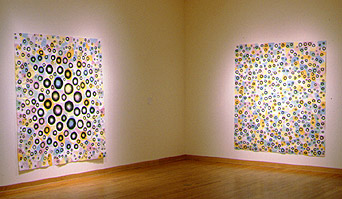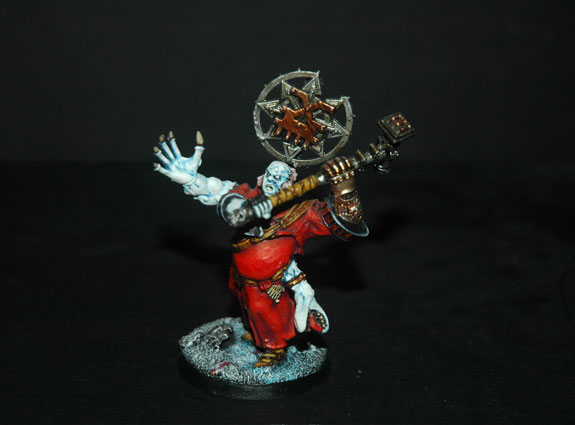View current page
...more recent posts
"Two billion years ago, it [the Sun] blew up, and the Earth was blown apart with it...The exploding Sun shattered the Earth and cast the hot debris into the cold darkness of the void...A few thousand years ago, an intelligent being from a reality we had never suspected found our dust. For its own alien purposes and by its own strange science, that intelligent being read in our dust the cryptarch of our lives...From our cryptarch, the alien created us again. And not just our bodies. You remember Earth because your consciousness, which is in fact a wavepattern of light emitted by your brain, was retrieved from the vacuum, where it had been expanding at the speed of light since you died...The alien is not a spiritual being...The truth is, this being regenerated you to serve as bait for yet another alien intelligence, its enemy, a species of sapient, winged spiders called zotl. Zotl eat people."
That passage from A. A. Attanasio's The Last Legends of Earth* gives you the flavor of the book: high pulp of cosmic sweep, and "pulp" is used here with reverence since it is in the discarded and unvetted we often find the best art. (The position of this page is that you can take your books about aging college professors finding passion, then ennui through affairs with young students and fuckin' stick 'em. So to speak.) Attanasio's tome seamlessly meshes heroic fantasy--his main character is a reconstituted Viking with a "ramstat flyer" instead of a longboat and his near-omniscient aliens meddle in human affairs like Greek gods--with skeptical, even new wave-y plot quirks. The novel peaks about 3/4 of the way through its 481 pages and the remainder is a series of short story-like vignettes of characters living in the biological, post-human end times before the alien's constructed binary star system collapses. Oh, yes, and it's also a love story.
The book belongs in the company of Michael Swanwick's The Iron Dragon's Daughter and Brian Aldiss's Helliconia tales in being both epic and wised-up, although its exalted, utterly committed narrative style feels almost Biblical. Attanasio's imagination is so huge you feel your head ballooning to embrace his conception of a universe where particle physics, time travel, Lovecraftian elder gods, and medieval warriors and peasants all mesh in a grand narrative. The poetry of his language, which can be felt even in the pulpiest sentences, drives the yarn as much as the mind-blowing science. The author was in his late 20s when he wrote this (it appeared in '89) and almost perfectly balances visionary abandon and storytelling control. A close televisual equivalent might be the Japanese anime series Neon Genesis Evangelion, which also injects apocalytic religion into futuristic sci fi with its incendiary battles among superhuman AIs.
*The edited passage in the first para. came from an amazon reader. Link is to Barnes & Noble, a "blue" company, unlike amazon. Hit Bush backers in their wallets!
Sidney Blumenthal in Salon (no link due to subscription-only firewall):
If he [Libby had] testified truthfully in October 2004 the result would have consumed the final days of the [presidential election] campaign. His Leninist logic permitted him to protect the Republican cause, but he has tainted Bush's victory in history as surely as the Supreme Court decision in Bush v. Gore did in 2000.Illegitimate pretenders to power still rule us. That doesn't make the 59 million who voted for Bush any less pathetic, though.

"Protest Song (Human Crab Louse)" [mp3 removed]. Work in process? Probably more like a prototype. The "found sequence"-- an Electribe rhythm pattern slowed down by about 16 bpm and reinterpreted by the computer as a melody kind of trails off into inconsequentiality every few bars, and that could be made more catchy and bouncy. The melody, such as it is now, sounds good in other Sid patches, to my ears at least, and those could be incorporated into the song with MIDI program change messages. One thing I learned is I don't have my volume problem with the analog drum machine if it's only playing a few hits (e.g. one kick, snare, clap, and one hi hat). It was only when I tried to use the full range of the machine that I had to turn the gain down--this tune is punchier and I didn't have to drop the volume.
A friend emailed to say he finds the synth sounds I'm using to be a little too much like factory presets--what come packaged with the instrument before any user programming. He says he's not sure if it's "the lack of layering, or that they're dry and don't have many filter/pitch/mod/etc controls." He likes the "Guitar Solo" video, though. I replied:
Thanks for the suggestions. I haven't made any pretense on the page of using anything other than presets. My feeling is MSPaintbrush is one big preset, and your suggestions would be like telling me I should use more layering and effects in Photoshop, to try to be more naturalistic and painterly. Not saying I'm not listening and won't absorb some of [the ideas in your email], but I like things straightforward and stupid. The guitar solo was a total one-off, I had just bought Kontakt and started turning as many knobs as I could find--it started getting distorted. The piece got more interesting when I started chopping the notes up and repeating them in a Wav editor. There's really no layering. It's just off the shelf distortion and brute surgery.
But I'm interested in the compositions being some basic, minimal, easily apprehended structure as opposed to building up a lot of texture in the sound. In "Clip City" I meant to contrast the subtle drumming with that dorky keyboard arpeggio I wrote and played absolutely dry on the Sidstation. The thought of doing a fluid, Basic Channel type drum track appealed to me, but then I just rebelled. The only analogy I can come up with is bad painting. Why would you want to do something bad when you can do something well? (A dealer once asked me that.) On "Permanent Chase" I added a little chorus effect to soften the Sid, but it's totally preset city. I really like the sounds those Swedish guys programmed! I've been lurking on some electronic music chatboards and am amazed by some of the complex things people are doing with drum programming etc. But I find the glitchy granular sound overrefined and boring. My favorite techno music is blindingly obvious. I think maybe I don't care about layering and quantizing because I like to hear all the instruments, and I like machines to sound like machines. Kraftwerk always appealed to me because it was wind up music, like looking at the inside of a watch and seeing how the gears move.
My friend replied that part of his confusion about the music was "that it's kind of sitting somewhere between german trance and a more minimal conceptual sound work, and I guess my personal preference would be for it to be a little more one way or the other." I'm abbreviating his comments, which were fairly detailed in how the music could go in either direction. I appreciate the suggestions but I'm resisting, as I explained in my emailed reply:
I guess my feeling is "german trance" and "minimal conceptual sound work" are both known genres, with their own sets of conventions, but the space between the two is maybe not to so mapped out. I'm not just trying to turn your criticism into a compliment. I think all my best work occupies that awkward middle ground between "failed commercial art" and "conceptualism with imagery too stupid to look at."
Where I'm still a little uncertain is, do I really need to learn to make good trance with all those subtleties you mentioned, or is it possible to fail at it for artistic purposes with only a working half-knowledge?
Part of me would like to be a club star with German girls putting their hands in the air, which is maybe why the music gets better without being entirely there as dance music. I keep working at it because I like it.
But trance is basically a dead art form. What is the point of getting really good at it?
Sounds like maybe the one that's bugging you the most is "Lysergic Interlude"? Those are definitely presets, from the Linplug Alpha softsynth: one is called "club run." I can hear everything you're criticizing about its lack of subtlety, but at the end of the day I just like that wind-up music box feel. (I subtitled it "Ice Cream Dude Sells E" because it sounds like an ice cream truck to me.) And there's almost nothing conceptual about it.
Anyway, I know the music's not perfect. I'm just leery about improving it too much because I don't know how relevant or valid "good" techno is at this point. I also feel the deconstructive art things (with sustained loops etc) are either too familiar or not fun. (Not saying [your piece you described in the email] is bad--I'm sure it's great.) There was a lot of finesse in the music in the Whitney's BitStreams show but not one composition had a beat or a melody. My hope is to keep working in the middle ground and a few good things will emerge from that process
And is if that wasn't enough, I added in a later email:
The bigger philosophical issue for me is the same issue I faced as an visual art student years ago. I had a teacher who left a note in my portfolio at semester-end saying I needed to "face very squarely" whether I was a cartoonist or an artist, because he saw the former winning out most of the time. Arguably he was right and that's why I [am where I am today], ha ha. As for making "good" techno--part of me wants to, but part of me wants to stay innocent and incorporate the misconceptions, fixes and workarounds of the self-taught musician into the final product, which loiters irritably halfway between trance and conceptual art. (The musical equivalent of my paintings, maybe.) BTW, the recent songs that matter the most to me are "Posse on Greenwich," "Glitch Western," and "Robollywood," none of which are actually that trancy.
Is it possible to contribute to a Tom DeLay legal offense fund? That sleazy criminal, sorry alleged criminal, has all the money in the world to out-lawyer and out-maneuver the poor beleaguered public official who finally indicted him. Like today, his successful tactic of getting the judge in his money laundering trial replaced because the man made some contributions to the Democrats.
What is it going to take to get rid of DeLay, the human crab louse? I'd give a hundred dollars to Ronnie Earle in Austin. Anybody else?
 An excerpt from the interview Cory Arcangel did with me at Rhizome.org [dead link - see below]:
An excerpt from the interview Cory Arcangel did with me at Rhizome.org [dead link - see below]: "The computer still has the shock of the new, or the shock of the bad in some cases. Art world folks know painting, photo, and printmaking lore, but are less secure--myself included--knowing what constitutes talent on the computer as opposed to some easy-to-do technical trick. I thought because everyone had Paint or the equivalent on their computer and had at least made a mark or spritzed the spraycan, they could see that I was doing something more ambitious with it. I was thinking of this guy in New Mexico who made perfect perspective drawings using an Etch a Sketch. If I could draw La Femme Nikita from scratch on this toy program and actually have people (well, guys) say she's hot, then a landmark would be achieved for both Paintbrush and the computer. The problem is I drew her so realistically people assumed I was running a photo though a pixelating filter.
"When I talk about craft on the blog, just to make it clear, I'm not talking about drawing ability but things like mosaics and needlepoints that relate to the computer on a much more fundamental image-making level, the grid level. I love the cross-stitch patterns and beadwork you can find online based on MSPaint drawings. In the late '90s I was impressed by the writing of cyberfeminist Sadie Plant, who opened up for me a whole organic, non-analytical way of looking at computation. She traces digital equipment back to one of its earliest uses, as punchcards for looms, and talks of the internet as a distributed collaborative artwork akin to traditionally feminine craft projects At the time I was drawing and printing hundreds of spheres at work and bringing them home, cutting polygons around them, and then taping the polygons back together in enormous paper quilts. In my press release for the Derek Eller show we called it 'corporate tramp art.'"
Update: New Link to Cory's interview with me.
Continuing my unbirthday celebration, this image arrived by email, with the caption INVINCIBLE. Another gem. Thanks to Diana and Matthew, and Luke for the badass figure.

